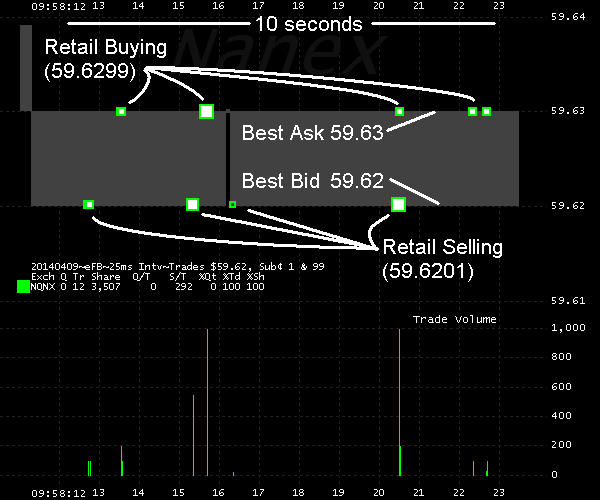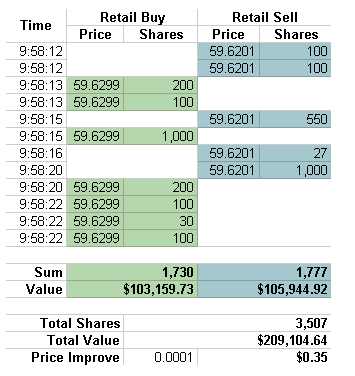Nanex Research

Nanex 09-Apr-2014 ~ Economically Insignificant Price Improvement
Unwanted Touching?
Did you know that most retail stock orders never execute on an exchange? Most retail
orders are "internalized" by a "wholesaler" or more aptly, an "internalizer", many of
which claim they match retail buyers and sellers, and even give both buyers and sellers a little extra - something they call "price improvement". Which sounds great, until
you realize that buyers and sellers aren't actually getting matched to each other: even
when a buyer and seller send their orders at the same time - even within the same second.
Below is a real-world example of this: the chart shows several retail buy and sell orders
executing over a 10 second period of time in Facebook stock. You can just barely make
out the "price improvement" - the squares, representing trades, are l/100th of a cent
inside National Best Bid/Offer, represented by the light gray shading.
Examples like these are suprisingly common - a typical day in Facebook stock alone has
about 10,000 sub-penny trades with the minimum $0.0001 price improvement per share and
at least 10% (1,000) of these trades involve buyers and sellers executing within seconds
of each other.
See also this page showing the same thing happening in Apple.
1. Facebook Retail Trades on April 9, 2014 ($0.0001/share "Price Improvement")
Note how retail buyers and sellers never actually meet, even when their orders arrive
in the same second. An intermediary is always present. Worse, those who posted liquidity
to an exchange (were willing to buy at 59.62 or sell at 59.63) will see their orders
unfilled and wonder how they too could offer 1/100th of a cent more or sell for 1/100th
of a cent less than the NBBO. This is called getting sub-pennied. You can read more
about it in the links below.

We've published a number of in depth
analysis on sub-penny trades:
The table below lists Facebook trades shown in the chart above. Most retail trades can
identified by trade prices with 4 decimals of precision: for buy orders, the last 2
digits will be between 90 and 99 and for sell orders, between 01 and 10. In this example
all buy orders had a trade price of $59.6299 and sell orders had a price $59.6201. The sum of shares from Retail Buyers is 1730, while the
sum of shares from Retail Sellers is 1777. This example presents practically zero risk
to the internalizer.
Note that Retail Buyers and Retail Sellers don't directly exchange stock - even though
many times a buyer and seller arrive in the same second. Also, rather than being matched
at the midpoint, a wholesaler or internalizer comes between (intermediates) every buyer
and seller. The internalizer magnificently gives the buyer or seller an extra $0.0001
per share. That works out to 35 cents of price improvement on $209,105 worth of stock.
Some will argue that 35 cents is better than nothing, but those making that argument
conveniently leave out the third party involved in practically every one of these transactions.
That third party is someone (often an investor) who posted liquidity to the market,
yet as a group, ends up losing about a billion dollars a year (read
more) to this price improvement scheme.

Nanex Research
Inquiries: pr@nanex.net


